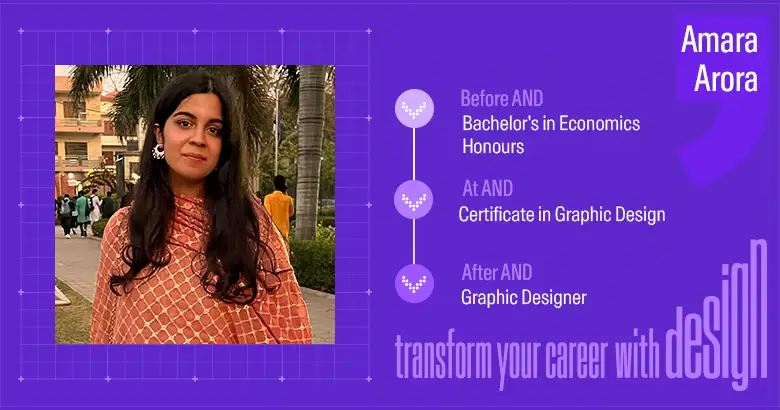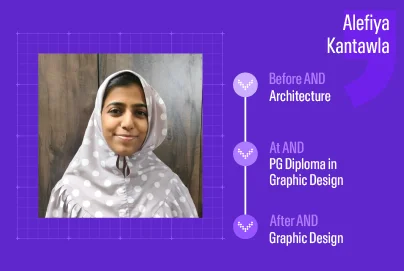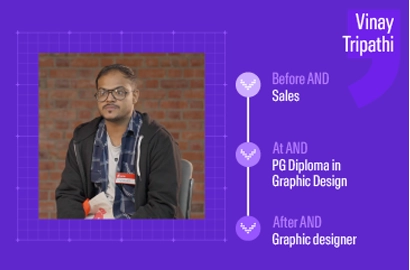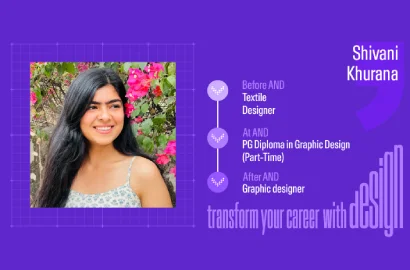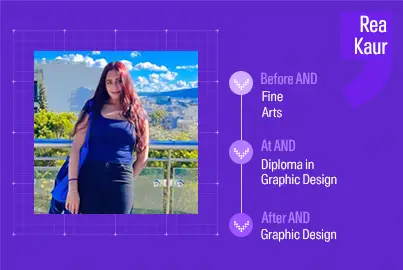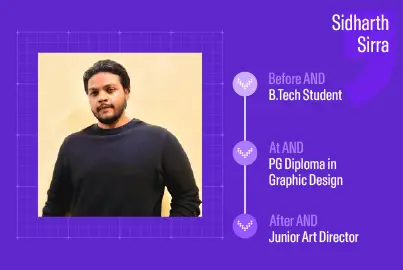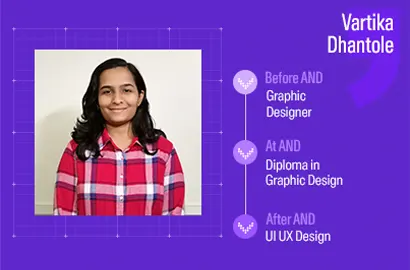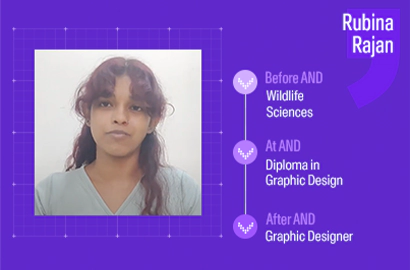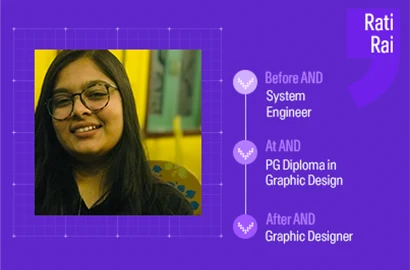In this edition of our student journeys, Economics student Amara Arora dives deep into her learning experience with AND Academy alongside a thorough walkthrough of her final project.
‘I decided to go ahead with AND Academy due to its extensive curriculum. I found it to be quite balanced, and it also blended a lot of practical skills with creative exploration.’
Back with yet another inspiring journey, joining us for this student interaction is Amara Arora, an AND learner who has recently completed her Certificate in Graphic Design course.
Amara comes from a non-design background and is currently pursuing a Bachelor’s degree in Economics. Shedding light on her interests and experience at AND, she takes us through her final project, focusing extensively on her approach and process.
Here’s an overview of our conversation:
- Amara’s background and interests
- Why she pursued Graphic Design at AND Academy
- Walkthrough of her Final Project
- Her design process
- The best aspects of her experience at AND
- Her career aspirations
- Advice for design enthusiasts
- Experience collaborating with peers
- Key ingredients of a good graphic designer
- Would you refer AND to peers?
Let’s begin!
Q1. Let’s start with a little bit about you. What is your background? What are your non-design interests?
So, I’m actually still a second-year bachelor’s student. I am pursuing Economics Honors from Mount Carmel College, Bangalore. I have recently completed my Certificate in Graphic Design course at AND Academy, and am now looking forward to joining the Diploma Program. In terms of interests, I think my hobby is quite unique. I enjoy watching video essays.
Wow, that sounds like a very niche interest. Can you tell us more about it and how you came to form this interest?
To give you a brief idea, video essays are essentially any information presented in a video format. It’s like a standard essay just converted into a video with animation to make the content more engaging. How I developed an interest in this is a story in itself.
So, I actually don’t have a habit of reading. This usually becomes a problem when it comes to taking up research for college projects. I was struggling with research on a topic when I came across video essays. Given the animated format, I found them extremely helpful for understanding concepts and gathering information on different topics. In fact, the Wall Street Journal has a whole series of these videos that cover aspects like the economics behind Trader Jewels. I find these much more interesting in terms of seeing and understanding things than just reading a page of letters. So that is how I got into this.
Oh wow. I think I can see some clear signs of how this could have gotten you into design.
Q2. How did you discover your interest in graphic design, and what motivated you to pursue a course with AND Academy?
I think the most important driving factor behind my getting into graphic design was my parents, who are self-taught designers and played a significant role in nurturing my appreciation for aesthetics and functionality. However, while my parents did influence my career choice at large, I was actually not interested in graphic design as a profession for the longest time. My interest in graphic design stemmed from my work and internships with streetwear and interior design brands.

I had taken it up thinking it would be a good opportunity, and since my friends were also involved in the field I thought I’d try it out as an exercise to explore my interests. To my surprise, once I started working I realized there was a lot more to graphic design and that is when my interest in the field as a career began.
When it came to pursuing a graphic design course, I decided to go ahead with AND Academy due to its extensive curriculum. I found it to be quite balanced and noticed that it also blended a lot of practical skills with creative exploration. Additionally, AND’s courses come with a very flexible online format which allowed me to balance my studies in economics as well as pursue graphic design simultaneously.
That makes sense. Moving on, your mentors speak highly of your project.
Q3. So, it’d be great if you could take us through your project and everything that went on in the background.
Yes, sure. So we were all assigned a different brand as a part of the project, and the primary task here was to showcase the motive of the brand through a social media carousel. I was assigned Slurp Farm and the end goal was to announce the arrival of a new product which was “Millet Noodles” and help distinguish the product from other competitors in the market through this carousel.
I started by conducting thorough research on the brand to understand its core identity before moving ahead with any kind of ideation. The design inception sheet in particular is one activity that helps with getting into the core of each aspect of the brand and identifying the mood and typographies. Using the sheet, I started contextualizing the brand, and then I divided everything into keywords and smaller elements to segment the post.
We also had to do a visual brand study. So I started by finding different social media posts which the brand had done on their Instagram profile to gauge the audience they were targeting. I also had to identify any posts that stood out from what the brand usually posted or look out for anything that stood out from what other brands were doing. I realised quite quickly that Slurrp Farm’s posts were designed for a younger demographic but targeted the parents. Their Instagram reflected a lot of visuals with playful settings, bright colours and cartoon illustrations focusing on what food or dietary items one could give kids. This initial research helped me understand the key characteristics of the brand, which mostly covered keywords like organic, healthy, and delicious food for children.
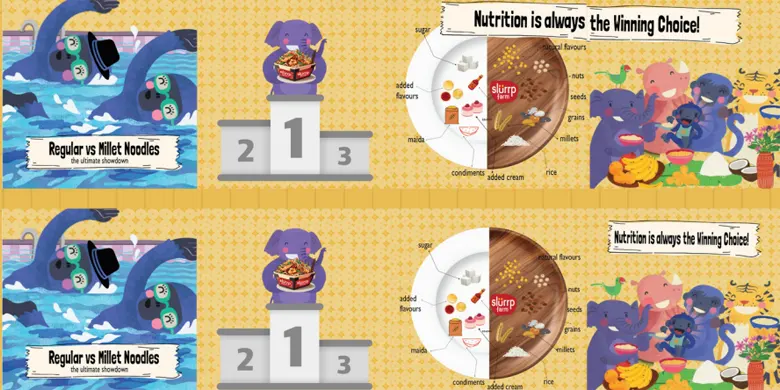
Initial design with Slurrp Farm’s original illustrations
Once I had a clear understanding of the brand audience and messaging, I moved on to the Miro board for ideation. This was the stage where I focused on the selection of the colour palette and the graphical elements. To retain brand consistency in my carousel I decided to use the original illustrations.
The typography was something that took us a lot of time because Slurrp Farm uses a lot of different fonts in their posts. For instance, while some posts used the font Lentils, the actual logo had a completely different typography. Choosing the right font and typography, hence, was one challenge that I faced, but it also turned out to be one of the key elements of the post I created.
One essential aspect of the project was segmenting my posts based on people, places businesses, and settings that I wanted to target. The aim was to find the perfect balance between the outcome, the messaging of my posts, and the different strategies for incorporating it in the design. For instance, the question of whether I wanted the posts to showcase the ease of cooking Millet Noodles at home, or the fact that all raw material is sourced through local farmers, was an essential aspect. Similarly, how I wanted to position the brand in the market was another challenge. This meant deciding to promote Slurrp Farms as either a sustainable brand or for its culinary innovation. These essential branding and business-focused questions needed to be addressed before I started designing the social media carousel.

Sketch from Crazy 8 activity
The approach I took was to research the different USPs of the brand and then create a visual bank of different elements I wanted to use. Another cool activity we took up was Crazy 8, where we had to come up with eight different ideations within 8 minutes. These rough sketches eventually helped me ideate my first carousel which I later modified based on the feedback I received from my mentors. Based on this feedback I created several variations for the carousel, and my overall messaging also focused on a parent’s concern about their child’s dietary habits.

Final designs with AI generated images
Since my approach had significantly changed, I decided to switch to AI-generated images for the final carousel instead of using the original illustrations. This also helped me better showcase the difference between regular noodles and millet noodles and design specifically for my target audience, which was mothers. The motive was to encourage them to choose millet noodles instead of just completely removing noodles from their kid’s diet. This was an important aspect since we often associate noodles with junk food.

Use of signature tagline and celebrity figure
The final carousel, hence, featured a comparison of different noodle types, the use of keywords for easy understanding, and the incorporation of a celebrity figure, Mira Kapoor, to connect with the audience. I also used the signature ‘ Yes ka time aa gaya’ slogan that Slurrp Farm usually uses in their marketing collaterals.
That sounds like a wonderful project. Amara. Good job with it!
Q4. But I am curious, do you have a specific process you follow for your projects in general? Considering the fact that you’ve used both AI and hand-drawn images.
So basically, I feel that as a designer the first step is always to start with hand-drawn sketches because it helps you to come up with original ideas. If you avoid referring to the internet in the starting it allows you to just think and use your imagination. You feel more creative. And obviously, it all starts with research and initial ideation.

Practise hand-drawn sketches
At AND, my process also included peer and mentor feedback. Once we make variations, we get feedback in terms of how we can improve things. And, in between all of this, we keep having different sessions and activities on improving our skills and/or incorporating different elements. One example is the Crazy 8 activity I talked about. It’s a little difficult in the start but eventually really helped me enhance my own creativity.
So, it’s not like we are asked to suddenly create a carousel and expected to put forward something. Instead, we take a step-by-step process where we take one element at a time. I, for example, started with typography and then moved on to the colours, logos, and other aspects. That’s how it’s segmented so that we have a conclusive outcome.
Excellent. That sounds like a very structured process. Since you’ve talked about the process at AND, here’s my next question for you.
Q5. What according to you are the top 3 aspects of your learning with AND Academy?
Firstly, the interactive classes were a significant highlight for me. Engaging with the instructors and peers during these sessions deepened my understanding of design concepts, from basic principles to complex theories. The feedback on images provided on my work throughout these classes was particularly valuable. Even when peers didn’t speak up, the mentors ensured we had short team projects, typically lasting 30 minutes to an hour. This encouraged collaboration and allowed us to gain different perspectives on objectives.
The second key aspect of my learning experience was the project work. This hands-on application of theoretical knowledge to practical scenarios not only improved my technical skills but also enhanced my confidence in design. It contributed significantly to my final portfolio and prepared me to tackle real-world situations effectively.
Lastly, the guidance and insights from the mentors were invaluable. Their extensive industry knowledge was presented in a relatable and accessible manner. We discussed familiar brands like Spotify, Apple, and Pepsi, all of which helped in developing more strategic thinking by connecting industry concepts to everyday examples.
That’s great. Considering that you’ve already completed your certificate with us and now moved on to the diploma course, I believe you really enjoyed your experience with AND.
Q6 What are your current career aspirations? Is there any dream profession you wish to pursue?
My current career aspirations involve combining my knowledge of economics, which I am studying at university, with graphic design. I am particularly interested in exploring roles in branding and marketing, where I can strategically use my design skills to create compelling visual narratives that align with economic strategies.
But in the long run, I probably envision myself as a creative director working for a leading global brand that prioritizes sustainable practices as social responsibility. I think a position like that would help me bring together my skills in a more impactful way.
That’s an interesting way to bridge your skills.
Q7. If you could offer any advice to someone who’s taking a similar path as yours, what would it be?
My advice would be to embrace a multidisciplinary approach and not be afraid to change fields. There was a time when I believed I had to focus solely on economics and couldn’t explore other areas. However, diversifying into graphic design opened up unique opportunities and perspectives for me.
Be curious and proactive in your learning experiences. Don’t hesitate to engage with your peers and mentors, as their feedback can be incredibly valuable and provide new perspectives that you might not have considered.
Wonderful advice! You’ve also spoken a lot about different group activities.
Q8. How was your experience of collaborating with peers through activities and with your mentors?
Collaborating with peers was immensely helpful. During the design process, there were times when I felt stuck on one element and couldn’t think about the next step. Working with peers and participating in group activities helped me realize new ways to move forward and improve my work.
One particularly insightful group activity involved rating each other’s work. This exercise helped us understand what we could do better and provided valuable perspectives on our designs.
Q9. What according to you is the key ingredient to being a great graphic designer?
I feel empathy and understanding are very important aspects. You need to understand the brand and user’s needs, emotions, and experiences to create effective designs that resonate with them and their target audience.
So we’ve nearly come to the end of this conversation.
Q10. And my last question is, would you refer AND Academy courses to your friends and family?
Yes, absolutely. I’ve already recommended the program to many of my friends, and I believe they will join soon. I feel the program is very comprehensive and well-structured, providing numerous practical insights crucial for personal growth. There are also many sessions and webinars with industry experts, which are invaluable. It’s the best place for anyone looking to advance their skills, especially since the courses are offered online- a significant advantage in today’s world where not many top universities offer such flexibility.
Thank you so much for those beautiful words, Amara. It was a pleasure speaking to you and we wish you all the best for your journey. We look forward to seeing you in the Graphic Design Diploma batch!
Has Amara’s inspiring journey ignited the designer within you too? If so, follow her footsteps and become a skilled graphic designer with AND’s Graphic Design Courses today. If you are an experienced designer looking to upskill, you can also consider the Diploma or PG Diploma course in Graphic Design.
For further details, speak to our Course Advisors today!

